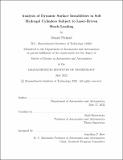Analysis of Dynamic Surface Instabilities in Soft Hydrogel Cylinders Subject to Laser-Driven Shock-Loading
Author(s)
Pickard, Daniel
DownloadThesis PDF (13.98Mb)
Advisor
Radovitzky, Raúl
Terms of use
Metadata
Show full item recordAbstract
Soft materials subject to both static and dynamic loading are known to exhibit a variety of mechanical instabilities which may lead to intricate surface deformation patterns. In particular, creases and wrinkles have been found to play an important role in the morphogenesis of soft tissues and tumor growth. Soft matter instabilities are also relevant to a number of manufacturing and engineering applications such as the fabrication of microlenses, and the development of soft robots, actuators and ŕexible electronics. Static instabilities in soft matter have been well studied theoretically, and they are known to result from bifurcations of equilibrium due to loss of convexity of the nearly-incompressible elastic strain energy function in the large deformation range. Under dynamic loading, soft solids exhibit many instabilities that are well known in ŕuids, including Rayleigh-Taylor, Faraday and Richtmyer-Meshkov instabilities.
This thesis is concerned with the analysis and mechanistic explanation of a new elastodynamic instability that was recently discovered at MIT. Laser-driven experiments performed at the MIT Institute for Soldier Nanotechnologies have demonstrated undulations along the surface of pressurized cylindrical specimens of soft hydrogels which develop on an intermediate timescale in between what is expected from classic static and dynamic instability mechanisms. In contrast to prior work, the novel instabilities have been observed only along external, as opposed to internal, soft solid boundaries. The new instabilities have not been observed in experiments using pure water and appear to be a unique and novel phenomenon. Motivated by these intriguing differences between the new observations and instabilities considered in the past, we aim to develop a theoretical and numerical framework geared towards understanding the fundamental dynamics leading to the complex mechanical deformations discovered at the Institute for Soldier Nanotechnologies. Among the insights obtained, it is found that the ability of a soft material to sustain large tensile hydrostatic stresses plays a pivotal role in generating the new surface undulations. The observation of tension-driven, shock-induced surface instabilities in hydrogels is indicative of hydrogel’s enhanced resistance to high strain rate cavitation when compared to pure water and may be of technological interest to a number of soft matter applications such as the design of protective equipment or the development of impulse resistant sealants, insulators and adhesives.
Date issued
2022-05Department
Massachusetts Institute of Technology. Department of Aeronautics and AstronauticsPublisher
Massachusetts Institute of Technology